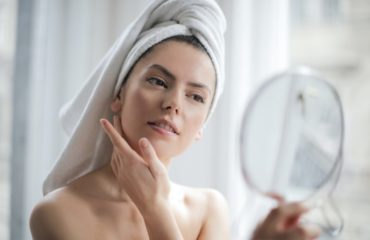
Pink petals float in the wind. The aroma of elderberry permeates the air. Pollen rises over the meadow, bees are buzzing in the grass. This idyll is suddenly broken by a terrible cough. I was six when I first experienced anaphylactic shock. I ran through a flowering field and suddenly began to suffocate. The air was hot, my heart was pounding. I barely made it home – and woke up in the hospital.
Since then, I do not participate in outdoor activities. Flowering meadows no longer seem innocent to me. I feel much better at home, in a cool room with closed windows, closed curtains, a humidifier and a stack of paper handkerchiefs.
Battle with ghosts
One rye ear contains up to 4 million pollen particles, a birch ear – up to 5.5 million, and a hazelnut branch – 600 million. Recent studies show that more than 60% of the population – carriers of the gene responsible for the possible development of allergic reactions. There are no statistics on the number of allergies, but of the total number of allergy sufferers, about 15% suffer from allergic rhinoconjunctivitis, and another 15% suffer from various forms of rash. Some people have asthma in general. Forecasts for the future are not very promising. According to the European Academy of Allergology and Clinical Immunology, by 2025, half of the EU’s adult population will suffer from any form of allergy. Doctors warn of the so-called “allergic tsunami”: the disease has become much more aggressive and dangerous than before. Most people do not take the symptoms seriously, and meanwhile untreated hay fever or allergies to animal hair can trigger severe asthma.
Substances that the immune system considers foreign are called antigens. Allergens are those that cause allergic reactions. Antigens that the body has already encountered are remembered by the immune system, and this is beneficial in the case of contact with bacteria, but is a defect in the case of allergies. Each subsequent reaction to the allergen will be stronger.
“Immunoglobulins (IgE antibodies), which are always present in small amounts in the body, can resist allergens. But when IgE in the blood of an allergy sufferer comes into contact with antigens – such as pollen – they mobilize the production of histamine, which just causes known symptoms – sneezing, red eyes and more. Its goal is to rid the body of allergens, “explains Dr. Albert Lubitz, a leading New York allergist.
Often, the reaction to an allergen does not appear immediately after the first contact, but may appear only later. Why this happens, has not yet been determined, but the culprit is not only the deterioration of the environment. One of the reasons, according to allergists, is a decrease in immunity due to excessive hygiene. Since the immune system has almost no chance of proving itself in the fight against infections since we were born, it becomes “bored” and throws itself into unnecessary battles with a safe environment.
Hereditary factors also play a role. “If one of the parents is allergic – the allergic reaction will occur with a probability of 30%. If both parents are prone to allergies, the risk increases to 60%. But this does not mean that the child of parents who have never had allergies is completely safe, “warns Sindhura Bandi, an allergist and immunologist at the Clinical Medicine Center in Chicago. Is it possible to get allergies in adulthood? “Unfortunately yes. In any “.
New gates
Until recently, pollen was thought to enter the body only during respiration, but recent studies suggest that it can penetrate the skin, severely weakening its protective barrier. “In hypersensitive people, it can cause a variety of unpleasant symptoms – up to eczema. Everything that happens in the body immediately affects the condition of the skin, and the increased amount of pollen in the air affects it as a mechanical stimulus, “- says Candidate of Medical Sciences from the Prague clinic Artmedica.
According to dermatologist Joshua Zeichner, allergic rhinitis itself also affects the skin. “Inflamed, watery eyes are rubbed with a napkin, so the area around dries and irritates. Swelling of the mucous membranes of the upper respiratory tract leads to dilation of blood vessels, the appearance of circles under the eyes and produces small veins. According to Dr. Clifford Bassett of New York, frequent wiping of the nose can lead to deepening of the nasolabial folds.
In 2018, Estée Lauder researchers found that pollen (as well as polluted air, ultraviolet light and blue light) destroys the skin’s natural barrier, irritates and affects collagen production. Can aggressive pollen be prevented? Before closing in the oxygen chamber before the beginning of winter, it is necessary to understand how to protect the skin even at the peak of the flowering season.
Measures of special humidity
Skin with a weakened protective barrier is prone to dryness, redness and itching. “Pollen is sticky, it clings to almost everything. When you get home, wash your face with a mild cleanser and freshen up with thermal water, ”advises Shani Darden, a cosmetologist from Los Angeles. It is important to strengthen the skin’s protective barrier so that pollen cannot easily enter the body. Dr. Barbara Sturm, whose patients suffer from allergies such as eczema and acne, agrees. “By defending itself, dry skin produces even more sebum than provokes inflammation.”
Allergy medications also dry out the skin. The mechanism of their action is as follows: the cells contain histamine receptors that affect the sebaceous glands responsible for producing sebum. But antihistamines block the work of these receptors. As a result, the amount of sebum is reduced and the skin is dehydrated.
The scalp is also at risk, because pollen particles are so small that they enter the bloodstream through hair follicles. “Wash your hair every day after returning home with a special shampoo for sensitive skin, and once a week do deep-acting detox treatments,” advises hairdresser Craig Hugan from the Stolen studio in Prague.
Almost all dermatologists recommend combining ceramides, antioxidants (especially vitamins C and E) and hyaluronic acid in skin care. It is important to look for labels on the packaging: calming, cooling and anti-redness – and avoid aggressive acids, harsh peels and retinol: they are likely to cause even more irritation – and you can get into a vicious circle.
Personally, I’m helped by the free Air Matters app in the App Store. It informs about air quality in real time and shows the current situation with pollen, so I always know exactly where I should not go.
The situation is complicated by the fact that allergy sufferers often use antihistamines to relieve symptoms, not the cause. They buy the wrong drugs, the side effects of which only aggravate the allergy. Many people suffer from several types of allergies at the same time, without suspecting it. To get the right diagnosis and make an algorithm for treatment, you need to be examined by an allergist, and although often the search for the pathogen is not easy, it is worth the effort.




